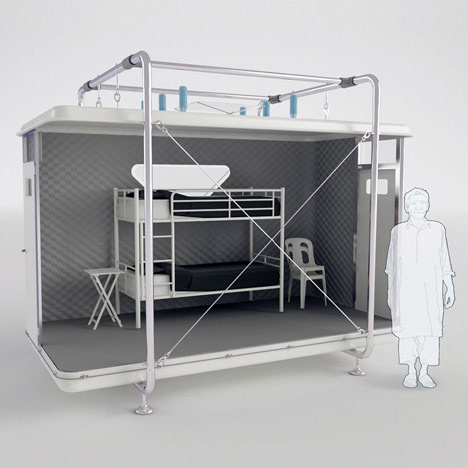Natural disasters can cause people to lose everything losing your home must be one of the hardest things to deal with. It also presents a difficult challenge for authorities to deal with as relocating thousands, if not hundreds of thousands of people is no easy task. When Hurricane Katrina ripped through New Orleans, citizens that lost their homes were instructed to stay in the Mercedes-Benz Superdome. After the Haiti earthquake, 1.5 million people were left homeless and had to live out of emergency shelters. Providing families robbed of their homes by disaster is key for transforming despair into hope.

https://www.dezeen.com/2018/10/02/stephanie-chaltiel-mud-shell-southbank-spraying-drones-emergency-homes-architecture-ldf/
As the world of technology advances, the way we construct emergency shelters has moved on from simple tent poles and tarpaulin. In 2018, Stephanie Chaltiel a French architect and her team constructed Mud Shell, a domed shelter made from bags of hay attached to a wooden lattice that is then sprayed with a combination of clay and fibre using a drone. Ancient building techniques such as wattle and daub were employed in combination with cutting edge drone technology to provide cheap, lightweight, waterproof and permanent housing. The structure can be constructed within four days, coating the dome by hand would take weeks, where the drone could achieve it in minutes. I think this is an interesting concept, but a construction time of four days seems too long. This type of solution outperforms a typical tent from a durability aspect but when faced with housing thousands of people the day after a disaster I can’t see people waiting around for these huts to be built. The question is how long do these temporary homes need to last? One of the world’s fastest constructed buildings is the 57-story, Mini Sky City in China that was complete within 19 days. Even if a 10-story building was built this would provide families with a permanent place they could call home.
Turkish creative consultancy Designnobis has approached the problem from a different angle. They have devised a temporary shelter that can be easily transported by truck and assembled on-site with ease. The moulded fibreglass roof and floor are raised off the ground by an aluminium frame. The walls are made from a weather-resistant quilted fabric with thermally insulated perlite. Fibreglass doors fold up from the floor to provide the occupier with more security compared to a tent door. The roof has been designed to bring in light and ventilation, as well as collect rainwater, which can be used as safe drinking water. The whole construction collapses into a 30cm high shell which allows for 24 units to fit onto a single semi-trailer truck. I think this shelter is a fantastic alternative to a tent, the ease of transport and assemble is a very attractive feature. I wonder if the pods could be adjusted to allow families to bring two together, so they don’t have to split up? Ensuring there is a modular aspect to the design is important as you want to be able to adapt quickly to various scenarios.

https://www.dezeen.com/2015/08/23/designnobis-pop-up-temporary-disaster-relief-shelter-earthquakes-tentative/
Shigeru Ban joined in the disaster relief effort in Okayama Prefecture, Japan, by providing a paper partition system for evacuees. The temporary structures were used to house evacuees affected by torrential rain that swept western Japan. Shigeru and a team of volunteers construct the modular system of partitions using recycled paper tubes, cardboard panels and fabric. After use, the materials can all be recycled again. I think providing privacy to victims when the effect of a disaster is still at the forefront of their mind is vital. Giving them time and space to comprehend what has happened and to plan their next steps is the answer to progress. I also think the use of simple materials is perfect for this application as it allows for easy construction, allowing for a faster response time.

https://www.dezeen.com/2018/07/31/shigeru-ban-temporary-shelters-paper-japan-flooding-architecture/
There are a lot of factors to consider when providing emergency shelter, how long is it for? is there any pre-existing infrastructure? is there a way to easily transport the supplies there? I think the key area that needs to be addressed is providing victims with a structure that can give them some privacy and time to understand what has taken place. Supplying this is the first step to recovery for the community and everyone else involved.